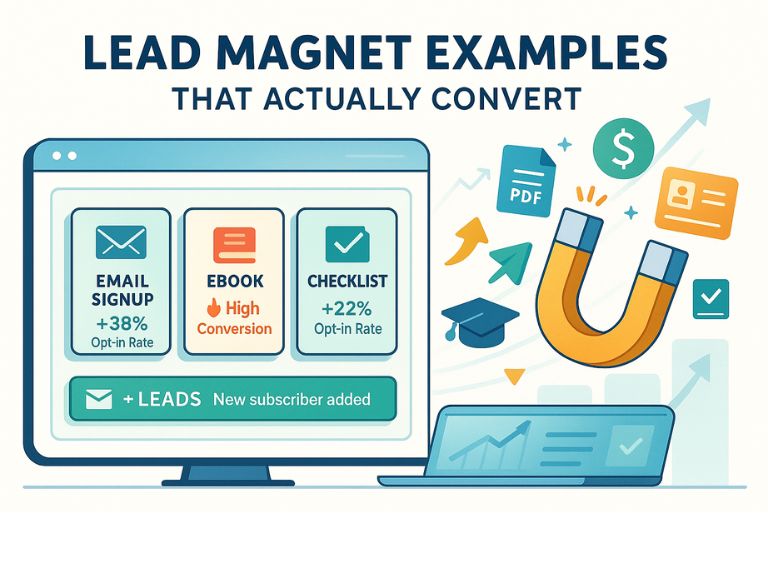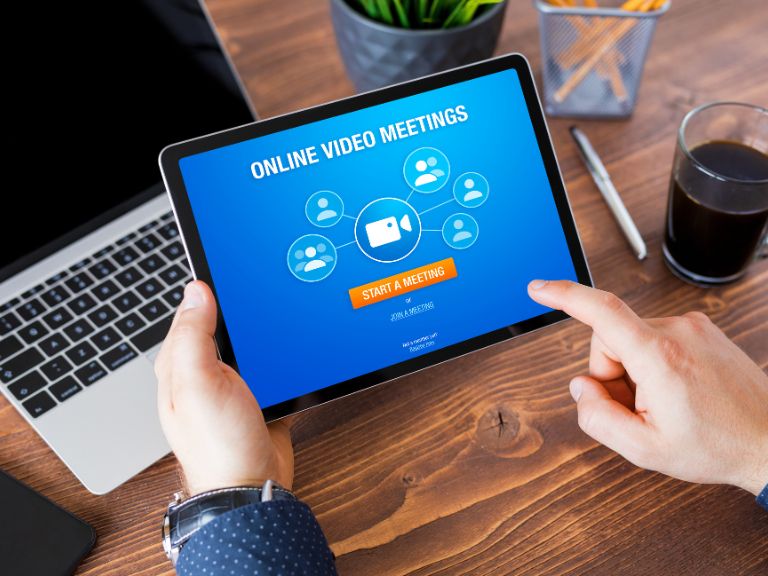Advice is easy to find. Everyone tells you what a lead magnet should look like. Few show you what actually works. That’s why so many creators and business owners end up with freebies that never convert; they collect clicks, not customers.
What drives real results isn’t more theory. It’s proof. Real-world lead magnet examples that show you exactly how successful brands turn attention into trust and trust into sales.
When you study proven examples, you see patterns: speed, relevance, and precision. You learn how to build assets that attract qualified leads, not random subscribers. And that’s where the shift happens from guessing what might work to repeating what already does.
This article breaks down real business examples, explains why they convert, and shows how you can adapt each concept to fit your audience and offer.
Key Takeaways
Lead Magnet Examples That Actually Convert
- Lead magnet examples convert when they deliver a clear, immediate result.
- Real-world models work because they solve specific problems fast.
- Alignment between offer, audience, and next step drives conversion quality.
- Proven examples double as filters, attracting only qualified leads.
- Placement and follow-up determine long-term success as much as the offer itself.
- Small adjustments in message or delivery often outperform new creations.

Why These Lead Magnet Examples Work Now
The digital space is noisier than ever, yet most lead magnets still sound the same. Generic PDFs and “subscribe for updates” forms don’t convert because they demand attention without earning it.
Today’s audience expects speed, specificity, and proof. They want to see progress within minutes of taking action. A high-performing lead magnet does exactly that: it delivers clarity fast and builds trust before any transaction happens.
What makes these examples effective is their precision. Each one solves a narrow, verified problem and creates a tangible outcome. Instead of trying to impress with volume, they win through relevance.
When your lead magnet removes confusion, gives momentum, or personalizes a result, it stops feeling like an incentive and starts functioning like value. That’s what builds belief and belief drives conversion.
According to HubSpot’s 2025 Marketing Insights, lead magnets that deliver a usable result within five minutes of engagement convert up to 2.8 times higher than traditional gated downloads.

Lead Magnet Examples That Actually Convert
Real lead magnets don’t win because they look good, they win because they solve something specific, fast. The following examples show what actually converts when execution matches intent.
1. The Interactive Quiz Personalization That Feels Effortless
A personal finance advisor runs a “Money Mindset Assessment” that scores users based on five quick questions about their spending and saving habits.
Each result page offers a short interpretation: “Saver,” “Balancer,” or “Spender” along with a tailored mini-guide. Afterward, users receive an automated email sequence with resources based on their result type, followed by a personalized invitation to book a one-on-one strategy session.
Why it works: Quizzes create curiosity and personalization instantly. They make users feel understood, not sold to. Each answer deepens engagement, while segmentation ensures every follow-up is relevant, turning interaction into insight.
2. The Template Kit Quick Wins That Build Credibility
A social media strategist offers a “30-Post Caption Template Kit” that helps small business owners overcome writer’s block. Each template includes fill-in-the-blank prompts, call-to-action options, and a short guide on tone and engagement.
The strategist also includes three examples of captions that performed well, showing proof of concept. After using the templates, many users book custom content sessions to maintain consistent posting.
Why it works: Templates remove friction and uncertainty. They deliver visible progress within minutes and make the creator’s expertise tangible. Once a user experiences results from the free kit, hiring the strategist feels like a natural next step.
3. The 5-Day Email Challenge Habit Building Through Micro-Results
A health coach launches a “5-Day Energy Reset Challenge.” Each day’s email delivers one small action: drink more water, stretch mid-day, sleep routine reset paired with a quick explanation of the science behind it.
Participants are encouraged to track their energy in a simple worksheet, which builds daily momentum. On day six, the coach sends a thank-you message and invites them to join a 6-week guided program for deeper transformation.
Why it works: Challenges extend engagement over time and create a behavioral link between small wins and future success. The repetition builds trust, while visible progress primes the audience for long-term coaching.
4. The Case Study Proof That Converts Skeptics
A marketing agency publishes a detailed “Client Growth Breakdown” showing how a small e-commerce store doubled revenue in 90 days using their ad framework.
The study includes before-and-after screenshots, ROI metrics, and a clear outline of the steps taken. Instead of a sales pitch, it ends with a free “Ad Strategy Audit” opt-in form.
Why it works: Case studies offer proof before purchase. They turn data into trust and attract leads already in decision mode. Readers see themselves in the story and move naturally toward requesting similar results.
5. The Toolkit Authority Through Curation
A productivity consultant releases a “Focus and Productivity Toolkit” featuring five curated apps, a printable daily checklist, and a short guide on managing distractions.
Each tool connects to a practical problem: time blocking, task batching, or goal tracking. The consultant subtly positions their paid coaching as the personalized system behind the tools.
Why it works: Toolkits combine simplicity with perceived authority. By curating trusted resources, the creator becomes a filter in an overloaded market. Each recommendation reinforces their credibility and builds natural curiosity about the deeper system that ties it all together.

How to Use These Lead Magnet Examples Without “Copying and Pasting”
Seeing an example that works can be inspiring but it’s also where most people go wrong. They copy what they see instead of understanding why it works. And when that happens, the result looks right on the surface but fails in practice.
A lead magnet that converts for someone else succeeds because it fits their audience, timing, and offer. Those conditions rarely match yours exactly. What made their quiz or template perform wasn’t the format, it was how it solved a specific pain point for their specific market.
To make these examples work for you, start by identifying what in the example created value. Was it the simplicity? The speed of the result? Personalization? Once you know that, rebuild the concept around your own audience’s trigger points.
If a quiz example caught your attention, study its questions. How do they connect to the offer that follows? If a case study performed well, look at how it framed proof, not just the numbers. The power is in the reasoning, not the replication.
When you stop copying and start reverse-engineering, every example becomes a blueprint not a shortcut. You’ll create something original that borrows the psychology, not the packaging.

Common Mistakes People Make When Using These Lead Magnet Examples
Even with proven examples in hand, many marketers still struggle to get consistent results. The problem isn’t the examples themselves, it’s how they’re copied, adapted, or delivered. Understanding where people go wrong ensures you apply these models strategically, not mechanically.
1. Copying Without Context
Seeing a great example and replicating it word for word might seem smart, but it rarely works. What converts in one niche may flop in another because audience intent, pain points, and awareness levels differ.
Fix: Borrow structure, not substance. Understand why an example works then rebuild it around your audience’s goals, language, and urgency.
2. Focusing on Format Over Fit
Many creators obsess over what type of lead magnet to build a quiz, a checklist, a toolkit instead of asking whether that format aligns with how their audience prefers to learn or act.
Fix: Match the format to the user’s mindset. Fast-action audiences prefer checklists. Thoughtful or data-driven users respond better to reports or assessments.
3. Ignoring the Follow-Up Sequence
Some marketers stop at the download. They deliver the magnet and move on, hoping the subscriber will remember them later. Without immediate follow-up, most leads lose interest within days.
Fix: Create a simple, automated sequence that continues the story. Reinforce the quick win, expand on it, and guide the subscriber naturally toward your offer.
4. Breaking Message Consistency
If your lead magnet uses a different tone or design from your main brand, it confuses the user. They may question authenticity or assume the free offer isn’t connected to your business.
Fix: Maintain consistent language, visuals, and brand values across every touchpoint. Your free offer should feel like a preview of your paid experience not a separate project.
5. Measuring the Wrong Metrics
It’s easy to get distracted by vanity metrics like downloads or sign-ups. But those numbers mean little if they don’t lead to qualified conversations or sales.
Fix: Track the right data. Monitor engagement rates, follow-up clicks, and eventual conversions. A smaller, active list always outperforms a large, silent one.
Authority Signature:
According to HubSpot’s 2025 Lead Conversion Trends, brands that personalize follow-ups and measure lead quality rather than volume achieve up to 2.3 times higher conversion rates across campaigns.
Create High-Converting Lead Magnets From Your Content In Minutes.
Transform your ideas, posts, and videos into irresistible lead magnets — each one designed to grow your audience and your sales.
Conclusion
Lead magnet success rarely comes from creativity alone. It comes from precision solving the right problem, in the right way, for the right person. The best examples in this guide work because they focus on outcomes, not format.
A strong lead magnet gives a fast, relevant win. It earns trust before the pitch, filters unqualified leads, and builds a pipeline of people already inclined to say yes. When you lead with clarity and proof, conversion becomes the natural next step.
You don’t need dozens of magnets or endless new ideas. You need one great example that fits your audience perfectly and reflects your core offer. Once that alignment clicks, every opt-in becomes the start of a predictable, scalable growth system.
According to HubSpot’s 2025 Marketing Insights, businesses that focus on a single, audience-aligned lead magnet generate 70% more qualified leads than those spreading effort across multiple untested offers.

Frequently Asked Questions (FAQs)
Which type of lead magnet converts best right now?
Interactive quizzes and short, actionable checklists consistently perform best across industries. They deliver instant results, personalize the experience, and require minimal effort from users three key factors behind modern conversion behavior.
How do I know which example fits my business?
Start by mapping your audience’s awareness level. Beginners respond to quick wins, like templates or quizzes. More advanced buyers prefer depth, such as case studies or toolkits. The right format depends entirely on the stage your prospect is in when they find you.
Can I reuse these examples in different niches?
Yes. These examples work across industries because they follow psychological principles, not trends. As long as your magnet solves a real problem and guides users toward the next step, the format remains flexible.
Do I need multiple lead magnets to grow faster?
No. One well-targeted, optimized lead magnet often outperforms several scattered ones. Expanding before perfecting splits focus and lowers quality. Scale by improving what works, not by producing more.
What’s the most common reason lead magnets fail?
Most fail because they lack follow-up. Capturing an email is only the first step. The conversion happens later through consistent, relevant communication that reinforces trust and connects the free offer to your paid solution.
Pingback: Steal This Lead Magnet Strategy Before They Do - Lead Magnets Creator
Pingback: Lead Magnet Generator: Creating Irresistible Offers in Minutes - Lead Magnets Creator
Pingback: Lead Magnet Ideas: Proven Ways to Attract Quality Leads Fast - Lead Magnets Creator